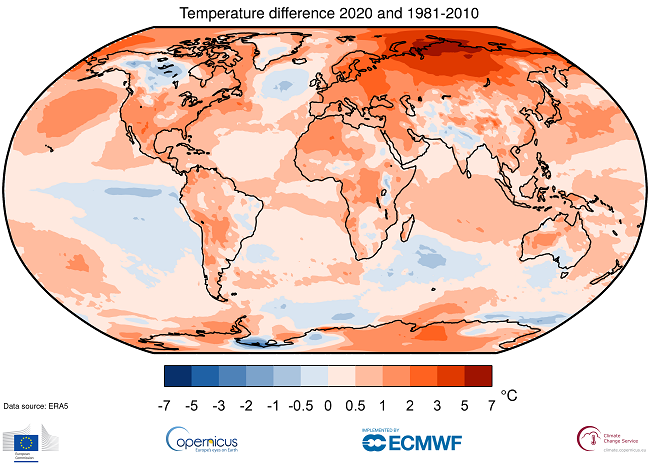The Copernicus Climate Change Service (C3S) on Friday, January 8, 2021 revealed that globally 2020 was tied with the previous warmest year 2016, making it the sixth in a series of exceptionally warm years starting in 2015, and 2011-2020 the warmest decade recorded.

Meanwhile, Europe saw its warmest year on record, 0.4°C warmer than 2019 which was previously the warmest year. Together with the Copernicus Atmosphere Monitoring Service (CAMS), C3S also reports that CO2 concentrations in the atmosphere have continued to rise at a rate of approximately 2.3 ppm/year in 2020 reaching a maximum of 413 ppm during May 2020.
Both C3S and CAMS are implemented by the European Centre for Medium-Range Weather Forecasts on behalf of the European Commission with funding by the European Union.
C3S’s dataset for surface air temperatures shows that:
- Globally, 2020 was on a par with the 2016 record
- 2020 was 0.6°C warmer than the standard 1981-2010 reference period and around 1.25°C above the 1850-1900 pre-industrial period
- This makes the last six years the warmest six on record
- Europe saw its warmest year on record at 1.6°C above the 1981-2010 reference period, and 0.4°C above 2019, the previous warmest year
- The largest annual temperature deviation from the 1981-2010 average was concentrated over the Arctic and northern Siberia, reaching to over 6°C above average
Furthermore, satellite measurements of global atmospheric CO2 concentrations show that:
- CO2 global column-averaged maximum reached 413 ppm
- CO2 continued to rise in 2020, increasing by 2.3 ± 0.4 ppm, slightly less than the growth rate of the previous year
Parts of the Arctic and northern Siberia saw some of the largest annual temperature deviations from average in 2020, with a large region seeing deviations of as much as 3°C and in some locations even over 6°C for the year as a whole. On a monthly basis, the largest positive temperature anomalies for the region repeatedly reached more than 8°C. Western Siberia experienced an exceptionally warm winter and spring, a pattern also seen over summer and autumn in the Siberian Arctic and over much of the Arctic Ocean.
Furthermore, the wildfire season was unusually active in this region, with fires first detected in May, continuing throughout summer and well into autumn. As a result, poleward of the Arctic Circle, fires released a record amount of 244 megatonnes of carbon dioxide in 2020, over a third more than the 2019 record. During the second half of the year, Arctic sea ice was significantly lower than average for the time of the year with July and October seeing the lowest sea ice extent on record for the respective month.
In general, the Northern Hemisphere experienced above average temperatures for the year, apart from a region over the central North Atlantic. In contrast, parts of the Southern Hemisphere saw below average temperatures, most notably over the eastern equatorial Pacific, associated with the cooler La Niña conditions developing during the second half of the year. It is notable that 2020 matches the 2016 record despite a cooling La Niña, whereas 2016 was a record year that began with a strong warming El Niño event.
Carlo Buontempo, Director of the Copernicus Climate Change Service (C3S), comments: “2020 stands out for its exceptional warmth in the Arctic and a record number of tropical storms in the North Atlantic. It is no surprise that the last decade was the warmest on record, and is yet another reminder of the urgency of ambitious emissions reductions to prevent adverse climate impacts in the future.”
Vincent-Henri Peuch, Director of the Copernicus Atmosphere Monitoring Service (CAMS), comments: “While carbon dioxide concentrations have risen slightly less in 2020 than in 2019, this is no cause for complacency. Until the net global emissions reduce to zero, CO2 will continue to accumulate in the atmosphere and drive further climate change.”
In the context of the COVID-19 pandemic, it has been estimated by the Global Carbon Project that there was a reduction of around 7% of fossil CO2 emissions.
“To what extent this was a factor in the lower total increase is debatable though, as the variations in global growth rate are dominated by natural processes. We must continue efforts to decrease CO2 net emissions to reduce the risk of climate-related change,” Vincent-Henri Peuch adds.
“The extraordinary climate events of 2020 and the data from the Copernicus Climate Change Service show us that we have no time to lose. We must come together as a global community, to ensure a just transition to a net zero future. It will be difficult, but the cost of inaction is too great, which is why the commitments made under our European Green Deal are so very necessary,” highlights Matthias Petschke, Director for Space, European Commission’s Directorate-General for Defence industry and Space.
In a reaction, Earth system scientist Johan Rockström, who is Director of the Potsdam Institute for Climate Impact Research, says: “This is not about one year being record warm – it is about the warming trend due to greenhouse gas emissions from fossil fuels. We look back on a terribly warm decade, with a terrible number of extreme events linked to that warming: droughts in the USA, wildfires in Australia, and the list goes on.
“The science is clear that we put our very life support systems at risk by heating our planet – never before in the history of human civilization have we had such warming. While annual temperatures can fluctuate, the dangerous warming trend will continue unless we rapidly reduce our CO2 emissions. We can do this, but we have to start doing it now.”
